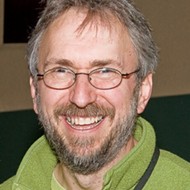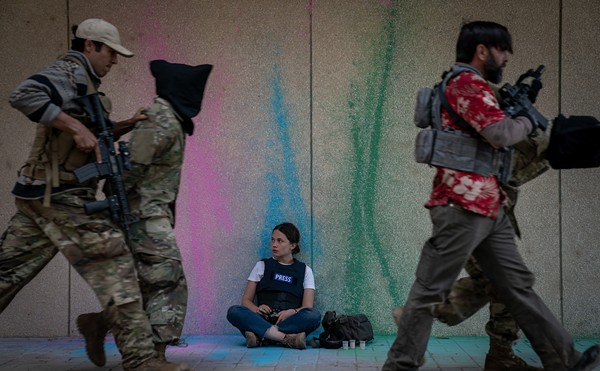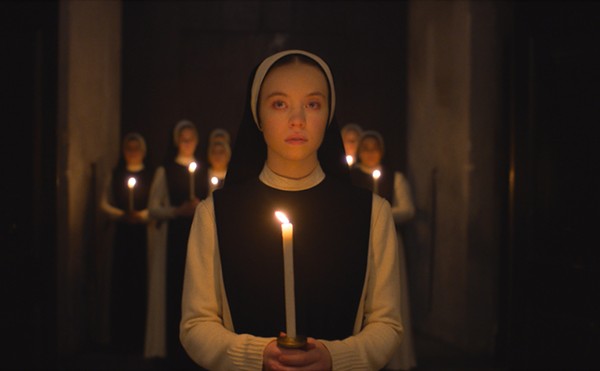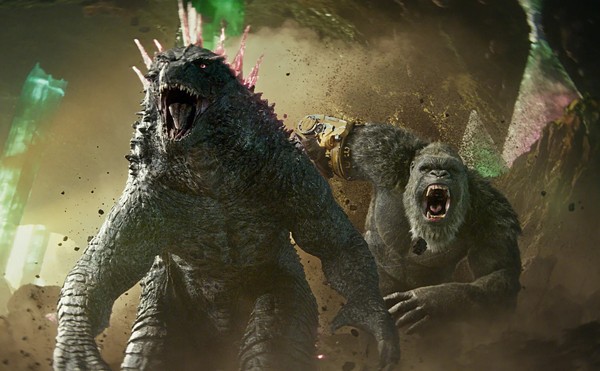Dave Wallace was a friend of mine.
No, that's not quite right. In fact, it's a lie. Let me rephrase:
David Foster Wallace felt like a friend of mine.
My reading of Wallace — my falling in drunken love with his intoxicating prose — began in 1996 with his astonishing Harper's cruise-ship essay, "Shipping Out" (later renamed "A Supposedly Fun Thing I'll Never Do Again" for an essay collection). Convulsing with laughter, I felt compelled to read aloud large swaths of the the piece to my largely bemused (though sometimes amused) wife. Wallace had that kind of electric, catalyzing effect.
Infatuation quickly grew to obsession: As a latecomer to the party, I quickly sought out previous work — his first novel (The Broom of the System) and his short-story collection (Girl with Curious Hair) — and purchased his buzzed-about, celebrated, epically long and daunting new novel, Infinite Jest. In subsequent years, I delighted in every Wallace sighting on the newsstand and in the bookstore, and I eventually reviewed — glowingly — both Consider the Lobster and Oblivion for the St. Louis Post-Dispatch. And after his suicide in 2008, I had the sad task of assessing the posthumously published, long-in-the-works, and ultimately incomplete The Pale King.
My interest in Wallace was ardent but scarcely unique, and as a subscription to the Wallace-1 listserv or a visit to the Howling Fantods website will make clear, I'm actually a relative dilettante: His work is scrutinized with rabbinical zeal by true devotees, every sentence parsed and endlessly analyzed.
All of which presents a problem for The End of the Tour, the remarkable film adaptation of David Lipsky's Although of Course You End Up Becoming Yourself, his 2010 account of a five-day road trip with Wallace through the upper Midwest at the exhausted finish of the Infinite Jest book tour. Wallace is such a beloved figure, and readers are so connected to and fiercely defensive of his work, that any film portrayal is likely to differ radically from their own mental pictures of the writer.
Donald Margulies, the Pulitzer Prize-winning playwright who adapted Lipsky's book for the screen, was acutely aware of the risk.
"I certainly felt a sense of responsibility," he says, "but I couldn't let that paralyze me. Wallace is one of those figures in our culture that people have such intense feeling about. I think part of that is attributable to his voice as a writer, because he was able to articulate things that people might have felt or seen but had not yet been able to articulate for themselves. It's a very intimate experience — the act of reading and hearing his voice in your head — and I think that's one of the reasons he had the hold he does on so many people who feel this sense of protectiveness and personal attachment to this man. I think that's a sign of greatness as an artist: to be one with his or her audience."
Further complicating matters, when the film was announced, the project was not embraced by Wallace's family, estate or publisher. In an April 2014 statement, Wallace's representatives said that they "wish to make it clear that they have no connection with, and neither endorse nor support, The End of the Tour." Part of the objection was the film's source: Lipsky was covering Wallace for Rolling Stone in 1996, but an article was never published, and the book — essentially a transcript of the interviews with interpolated observations — appeared only after Wallace's death. The literary trust wrote: "David would never have agreed that those saved transcripts could later be repurposed as the basis of a movie."
Those concerns may well have seemed warranted in advance of seeing The End of the Tour, but Wallace's fans (if not those people closest to him) should find the film a delightful surprise, despite early fears about the counterintuitive casting of comic actor Jason Segel as Wallace. Margulies observes: "When we took this on, we took it on with our eyes wide open, but also with a tremendous amount of respect and empathy and real integrity. All of us were very mindful of the portrayal and not deviating from those five days. I think when it was first announced that we were making this film, there was a misconception that this was going to be a biopic, like Gandhi or something, and that was never the idea behind this. It was really the fact that I became excited viewing this enigma [Wallace] through the lens of Lipsky over the course of this very abbreviated period of time."
Not everyone would have recognized the cinematic potential in Lipsky's long-form interview, but Margulies responded immediately when his manager, David Kanter, sent him the book for potential adaptation to the stage. He recalls: "I wanted to capture on film the experience I had of reading Lipsky's book — not knowing a lot about Wallace but finding through Lipsky what he was and what he meant and what he brought to the cultural conversation.
"I think that what excited me is the idea of these two intensely smart guys on the American landscape. So much of what Wallace wrote about was our culture, the culture of America, and to place this iconic figure on the very landscape that was his subject matter I thought was a very exciting thing that could only be conveyed through film and could not be done justice on a stage. It just would have been too confining.
"So much of what he was concerned with as a writer and as a man is the notion of how we find happiness and sustenance in America. The fact that they travel to the Mall of America, for instance, which is such a metaphor for American consumerism, and that so much of what he wrote about was people seeking entertainment, seeking distraction. And the fact that we can actually place them there, Lipsky and Wallace, talking about these very things that obsessed him as a creative writer, I thought was just a remarkable opportunity. It was calling out for that kind of moment in a movie."
Margulies, somewhat unusually for a screenwriter, was the driving force behind the project, and he serves as one of the producers. Margulies also recruited director James Ponsoldt, who was his student at Yale. "We had this burgeoning collegial relationship that came out of a mentor-protégé relationship," Margulies says. "So I sent the script to James, and he responded to it overnight. I have to say the script has changed very little since that day when he read it. It's tighter, it's shorter — he has very good ideas for cuts — and other changes had to be made for budgetary or location reasons, but by and large this script is what I wrote, which not too many screenwriters can say whose work is directed by other people. Very rare."
Lipsky's book, understandably, sprawls and meanders, but the screenplay perceptively homes in on several key themes, including one of Wallace's recurrent subjects: that insatiable need for entertainment and distraction that Margulies mentions above. Margulies observes of Wallace: "By his own admission, his only addiction in life, as he put it, was to television. That he would ask, 'Do you have a TV?' when they have just left attending a movie at the multiplex attests to that kind of need. The way that we're able to capture his watching Broken Arrow, John Woo's action movie, with such attention and commitment to the image is very moving. That, incidentally, is one of my very favorite scenes in the movie."
Lipsky only briefly recounts the Broken Arrow screening, but Margulies expands its parameters, and the following sequence, in which the two writers argue over Lipsky's perceived flirtation with a former girlfriend of Wallace's, isn't referenced in the book, which raises the question of invention in some minds. As Margulies says, "Some bloggers out there have taken me to task for manufacturing moments that actually occurred but were not included in the book." His response: "I spent several hours talking to David Lipsky. Lipsky generously gave permission to include some things that he did not include in the book, which for me as the dramatist and the adapter proved to be very crucial in the structure of the story."
Although Lipsky (played by Jesse Eisenberg) was frankly self-critical in his book, acknowledging his envy of Wallace's success with Infinite Jest — his own contemporaneous novel, The Art Fair, received laudatory reviews but modest sales — The End of the Tour ups his dickishness quotient and undersells his accomplishments. "I think I can safely say that David Lipsky loves the movie," Margulies says, but he admits to some necessary tweaking: "From my earliest encounter with him, I said, 'David, I'm going to be creating a character named David Lipsky, with quotation marks around it, and he's going to bear a resemblance to you but is not you.' And he said, 'I understand. Whatever you have to do.' He was incredibly generous in his response and understood that for dramatic purposes the screen David Lipsky is a little greener than he was at age 30 and there's more at stake for him. To a certain extent, that's dramatic license. David's reaction was remarkably lacking in vanity, and he understood that Jesse's version is a screen character that he's playing.
"It's not a documentary that we've made. We're telling a story, and the story is of a younger, less-acclaimed author in the presence of a giant in his field who he admires and envies and wants the approval of and wants a story from. There are a lot of agendas operating here."
Among those agendas is the jockeying for position between the two authors in telling Wallace's highly self-aware story: Both want control. On the surface, a friendship appears to develop between the men, but there's a falsity to the relationship. Margulies says: "One of the things that James Ponsoldt and I talked about was Janet Malcolm's book The Journalist and the Murderer, which is such a fascinating portrait of the kind of transference that occurs between a journalist and his subject. Almost in psychological terms, the way a patient and his analyst may become overly invested in each other. The lines, the parameters of the relationship at hand, are blurred when people begin to supply elements that aren't really there — they're artificial, they're neurotic. But they are intrinsic to that kind of dynamic, and we were very curious about that."
To explore this sort of territory, to effectively communicate the sophisticated ideas at play in the film, The End of the Tour places serious demands on its central pair of actors, and Segel and Eisenberg unfailingly deliver. "We needed to cast two verbally dexterous actors," explains Margulies, "and these guys are incredibly funny, smart and quick. The script asks them to lay out these complex ideas that are not always immediately visible. In other words, within the speech itself, you're not exactly sure where he's going with this — there's a certain kind of convolution within the speech until either of them makes his point, and it's an 'ah-hah' kind of moment. To convey that kind of thought process — of writers writing out loud essentially — is a very tough thing to pull off.
"We were blessed with two actors who have a real sense of ease with thoughts being expressed as we're watching them. Sometimes you see something where actors are saying things, and it's almost as though they don't fully comprehend what they're saying, and that was never the case here. There was a real sense of comprehension and empathy that informs every little nuance."
"Empathy" and "nuance" — two words that aptly (if only partially) capture David Foster Wallace's own work. Fortunately for Wallace's admirers, they also apply to The End of the Tour.







